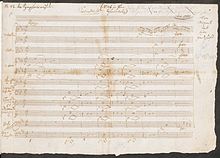
The Maurerische Trauermusik (Masonic Funeral Music) in C minor, K. 477 (K. 479a), is an orchestral work composed by Wolfgang Amadeus Mozart in 1785[1] in his capacity as a member of the Freemasons.
The autograph manuscript of the work is preserved in the Berlin State Library.
History
[edit]Mozart's own entry into his catalogue under the heading "July 1785" may be an error; he most likely forgot to enter a new heading for November.[2] It was performed during a Masonic funeral service held on 17 November 1785 in memory of two of Mozart's Masonic brethren,[3] Duke Georg August of Mecklenburg-Strelitz and Count Franz Esterházy von Galántha,[4] members of the Viennese aristocracy.

The work uses the Gregorian chant psalm-tone, tonus peregrinus.[citation needed] The work is scored for 2 oboes, 1 clarinet, 3 basset horns, 1 contrabassoon, 2 horns and strings.[5] The basset horn parts were written for fellow Freemasons Anton David and Vincent Springer.[1]
On 20 November 2021 a new arrangement by Giulio Castronovo, created to match the orchestration of Mozart's Requiem in D minor, K. 626, (2 basset horns in F, 2 bassoons, 2 trumpets in D, 3 trombones, timpani and strings[6]), was premiered in the Schlosskirche Bayreuth by the baroque orchestra La Banda conducted by Sebastian Ruf as an introduction to a performance of the Requiem.[7][failed verification]
See also
[edit]References
[edit]- ^ a b Heartz, Daniel (2009). Mozart, Haydn and Early Beethoven: 1781–1802. New York: W. W. Norton. p. 443.
- ^ "Symphonies: Series IV — Orchestral Works" (PDF). Neue Mozart-Ausgabe. 10 (11): IX. Retrieved November 6, 2018.
- ^ Rosselli, John (1998). The Life of Mozart. Cambridge University Press. p. 116.
- ^ Cliff Eisen (2006). The Cambridge Mozart Encyclopedia, Cambridge University Press, Inc. p. 168
- ^ NMA score, p. 12
- ^ "Mozart: Masonic Funeral Music (Maurerische Trauermusik) KV 477 – arrangement matching the orchestration of the Requiem KV 626".
- ^ "Mozart Requiem", Schlosskirchenmusik Bayreuth, November 2021 (in German)
Further reading
[edit]- Konrad, Ulrich (2020). "Fragen zur Maurerischen Trauermusik KV 477", Mozart Studien 27, pp. 155–176
External links
[edit]- Maurerische Trauermusik, K. 477 (479a). Mozart's autograph in the Berlin State Library
- Maurerische Trauermusik KV 477: Score and critical report (in German) in the Neue Mozart-Ausgabe
- Maurerische Trauermusik, K. 477/479a: Scores at the International Music Score Library Project
- Audio on YouTube, Vienna Philharmonic, Herbert von Karajan
Well, that’s interesting to know that Psilotum nudum are known as whisk ferns. Psilotum nudum is the commoner species of the two. While the P. flaccidum is a rare species and is found in the tropical islands. Both the species are usually epiphytic in habit and grow upon tree ferns. These species may also be terrestrial and grow in humus or in the crevices of the rocks.
View the detailed Guide of Psilotum nudum: Detailed Study Of Psilotum Nudum (Whisk Fern), Classification, Anatomy, Reproduction